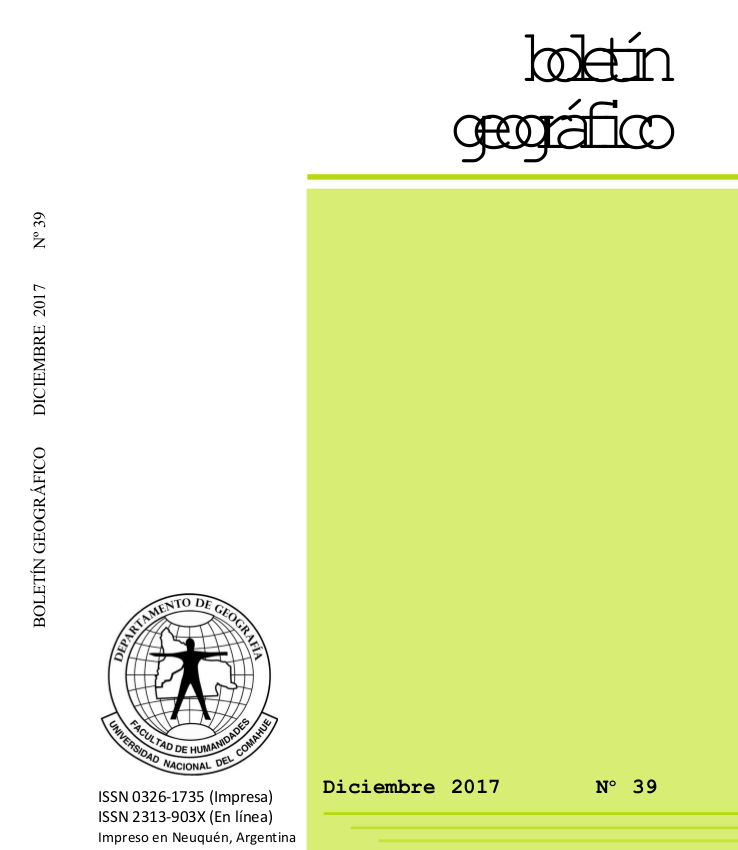Estudio de calidad del aire en canteras a cielo abierto en General Roca, Argentina.
Palabras clave:
Minería a cielo abierto, AERMOD, calidad de aire, material particuladoResumen
El presente trabajo tiene como objetivo proponer una metodología de estudio para evaluar calidad de aire en una actividad minera a partir del estudio de confiabilidad y análisis de los datos meteorológicos, topográficos y de emisiones, que se ingresan al modelo de dispersión. La metodología se aplicó a las emisiones de material particulado con tamaño menor a 10 μm (PM 10 ) generadas a partir de la explotación en canteras de yeso, cercanas a General Roca (Argentina); para luego evaluar su dispersión y su posible afectación a la salud humana y/o al ambiente. Se analizó las variaciones estacionales de la dispersión y se utilizó el modelo gaussiano de dispersión AERMOD. Del estudio se concluye que la dispersión de PM 10 en las condiciones atmosféricas y de emisión para el período considerado no presentó concentraciones en áreas urbanas cercanas a las zonas de canteras que excedan el límite legal. Del análisis de las variaciones estacionales de la dispersión se observó cambios en la extensión de la pluma y en la concentración máxima horaria, especialmente en el otoño e invierno. Los resultados de la modelación (valores de concentración máxima horaria) se compararon con datos de concentración de aerosoles, obtenidos mediante sensores remotos; resultando un ajuste con coeficiente de determinación R 2 ~ 0,7. La metodología de trabajo propuesta se puede incorporar como herramienta de control en organismos gubernamentales, para la evaluación y gestión de la calidad del aire de modo de prevención de escenarios no satisfactorios.
Descargas
Citas
Abril G., Diez S. (2012). Modelado de la dispersión de material particulado PM 10 mediante la estimación de las tasas de emisión considerando la influencia de la meteorología local. Memorias, XI Congreso Argentino de Meteorología. Mendoza http://www.congremet.prmarg.org/upload/abril-gabriela.pdf
Australian Govemment (2011).. Emission Estimation Technique Manual for Mining. Department of Sustainability, Environment, Water, Population and Communities.
National Pollutant Inventory Australian Government. Manual, Canberra, Australia, Ahmad S.P., Torres O., Bhartia P.K., Leptoukh G., Kempler S.J. (2006). Aerosol index from TOMS and OMI measurements. Proceedings of the 86th AMS Annual Meeting,Greenbelt. https://ams.confex.com/ams/pdfpapers/104496.pdf
Allende D.G., Puliafito E. (2009). Comparación de modelos de dispersión en el modelado de emisiones gaseosas industriales del gran Mendoza. Contaminación atmosférica en Argentina: contribuciones de la II Reunión Anual PROIMCA 103 -113. UTN., Mendoza, Argentina, Beychok, M. (1979). Fundamentals of stack gas dispersion. Irvine, CA.
Briggs, G. (1993). Plume Dispersion in the Convective Boundary Layer. Part II: Analyses of CONDORS Field Experiment Data. Journal Of Applied Meteorology, 32(8), 1388-1425. http://dx.doi.org/10.1175/1520 0450(1993)032<1388:pditcb>2.0.co;2
Caputo, M., Giménez, M., & Schlamp, M. (2003). Intercomparison of atmospheric dispersion models. Atmospheric Environment, 37(18), 2435-2449. http://dx.doi.org/10.1016/s1352-2310(03)00201-2
Chu, D.A., Kaufman, Y.J., Ichoku, C., Remer, L.A., Tanré, D. and Holben, B.N. (2002). Validation of MODIS aerosol optical depth retrieval over land. Geophysical. Research Letters. 29 (12), 1 - 4.
Cimorelli, A., Perry, S., Venkatram, A., Weil, J., Paine, R., & Wilson, R. et al. (2005). AERMOD: A Dispersion Model for Industrial Source Applications. Part I: General Model Formulation and Boundary Layer Characterization. Journal Of Applied Meteorology, 44(5), 682-693. http://dx.doi.org/10.1175/jam2227.1
Dobbins R.A. (1979). Atmospheric Motion and Air Pollution. New York: John Wiley & Sons.
Gassman M. y Mazzeo N. (2000). Air Pollution Potential: Regional Study in Argentina. Environmental Management. 25 (4), 375–382.
González D.E y Coglaiti M.G. (2016). Study of vehicle between Neuquén and Centenario, Argentina. Atmósfera 29 (3): 267 – 277.
Herrero J.C. (2007). Calidad del Aire Ambiental. Proyecto geoambiental del complejo volcánico Farallón Negro. Convenio SEGEMAR (EMPREMIN) – YMAD. Catamarca – Argentina. Proyecto. Argentina, 384 pp.
Huertas, J., Camacho, D., & Huertas, M. (2012). Standardized emissions inventory methodology for open-pit mining areas. Environmental Science And Pollution Research, 19(7), 2784-2794. http://dx.doi.org/10.1007/s11356-012-0778-3
Koelemeijer, R., Homan, C., & Matthijsen, J. (2006). Comparison of spatial and temporal variations of aerosol optical thickness and particulate matter over Europe. Atmospheric Environment, 40(27), 5304-5315. http://dx.doi.org/10.1016/j.atmosenv.2006.04.044
Neshuku M. N. (2012). Comparación de la actuación de dos modelos de dispersión atmosférica (AERMOD y ADMS) para fuentes de minería a cielo abierto de la contaminación del aire. Tesis. Universidad de Pretoria. Pretoria, Sudáfrica.
Palese C., Gardio l J.M., Lassig J.L. (2009). Mapas de velocidad media del viento en el centro–este de Neuquén. Meteorológica. 34 (1), 17 – 27.
Puliafito E., Rey Saravia F., Pereyra M., Pagani M. (2009). Calidad del aire en el Polo Petroquímico de Bahía Blanca. Contaminación atmosférica en Argentina: II
Reunión Anual PROIMCA. Universidad Tecnológica Nacional. Mendoza, Argentina, 114 – 122.
Prohaska F.J. (1976). The climate of Argentina, Paraguay and Uruguay. World Survey of Climatology. (W. Schwerdtfeger, Ed.). Elsevier. 12, 57-69.
Reed W.R. (2005). IC/9478. Significant Dust Dispersion Models for Mining Operations. Department of Health and Human Services (DHHS),. Informe. Pittsburgh, EUA,.
Silvester S.A., Lowdnes I.S., Hargreaves D.M. (2009). A computational study of particulate emissions from an open pit quarry under neutral atmospheric conditions. Atmosferic. Environment. 43 (40), 6415 – 6424.
Torres O., Bhartia P.K., Herman J.R., Sinyuk A., Gimoux P., Holben B. (2002). A long-term record of aerosol optical depth from TOMS Observations and Comparison to AERONET Measurements. Journal of the Atmosphere Sciences. 59, 398 – 413.
Turner D.B. (1970). Workbook of Atmospheric Dispersion Estimates. Environmental Protection Agency. EUA.
USEPA (1995). 450-AP42-5ED.Compilation of Air Pollutant Emission Factors, Volume I: Stationary Point and Area Sources. Environmental Protection Agency. https://www3.epa.gov/ttn/chief/ap42/ch11/index.html Recuperado Noviembre 2015.
Venegas L.E., Mazzeo N.A. (1999). Atmospheric stagnation, recirculation and ventilation potential of several sites in Argentina. Atmospheric Research. 52, 43–57.
Vidot, J., Santer, R., & Ramon, D. (2007). Atmospheric particulate matter (PM) estimation from SeaWiFS imagery. Remote Sensing Of Environment, 111(1), 1-10. http://dx.doi.org/10.1016/j.rse.2007.03.009
Wang, J. and Christopher, S.A. (2003). Intercomparison between satellite-derived aerosol optical thickness and PM2.5 mass: Implications for air quality studies. Geophysical Research Letters. 30 (21), 2095 - 2099.
Weil J.C. (1988b). Plume rise. Lectures in Air Pollution Modeling. (A. Venkatram and J.C. Wyngaard, Ed). American Meteorological Society. 119 –162 pp.
Weil, J., Corio, L., & Brower, R. (1997). A PDF Dispersion Model for Buoyant Plumes in the Convective Boundary Layer. Journal Of Applied Meteorology, 36(8), 982-1003. http://dx.doi.org/10.1175/1520-0450(1997)036<0982:apdmfb>2.0.co;2
Willis, G., & Deardorff, J. (1981). A laboratory study of dispersion from a source in the middle of the convectively mixed layer. Atmospheric Environment (1967), 15(2),
Publicado
Cómo citar
Número
Sección
Licencia
Derechos de autor 2017 Boletín GeográficoLa aceptación de colaboraciones por parte de la revista implica la cesión no exclusiva de los derechos patrimoniales de los autores a favor del editor, quien permite la reutilización bajo Licencia Atribución-NoComercial-SinDerivadas 2.5 Argentina (CC BY-NC-ND 2.5 AR)
Usted es libre de:
Compartir — copiar y redistribuir el material en cualquier medio o formato
La licenciante no puede revocar estas libertades en tanto usted siga los términos de la licencia
Bajo los siguientes términos:
Atribución — Usted debe dar crédito de manera adecuada, brindar un enlace a la licencia, e indicar si se han realizado cambios. Puede hacerlo en cualquier forma razonable, pero no de forma tal que sugiera que usted o su uso tienen el apoyo de la licenciante.
NoComercial — Usted no puede hacer uso del material con propósitos comerciales.
SinDerivadas — Si remezcla, transforma o crea a partir
El simple hecho de cambiar el formato nunca genera una obra derivada, no podrá distribuir el material modificado.
No hay restricciones adicionales — No puede aplicar términos legales ni medidas tecnológicas que restrinjan legalmente a otras a hacer cualquier uso permitido por la licencia.
La cesión de derechos no exclusivos implica también la autorización por parte de los autores para que el trabajo sea alojado en el repositorio institucional y difundido a través de las bases de datos que el editor considere apropiadas para su indización, con miras a incrementar la visibilidad de la revista y sus autores.
FORMULARIO DE CESIÓN DE DERECHOS DE AUTOR



















